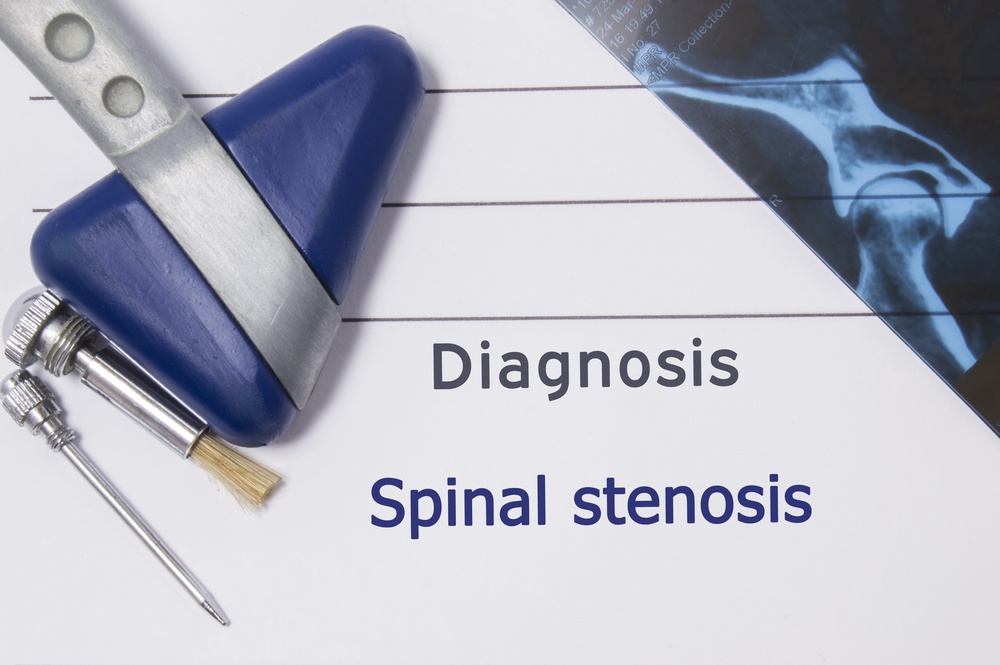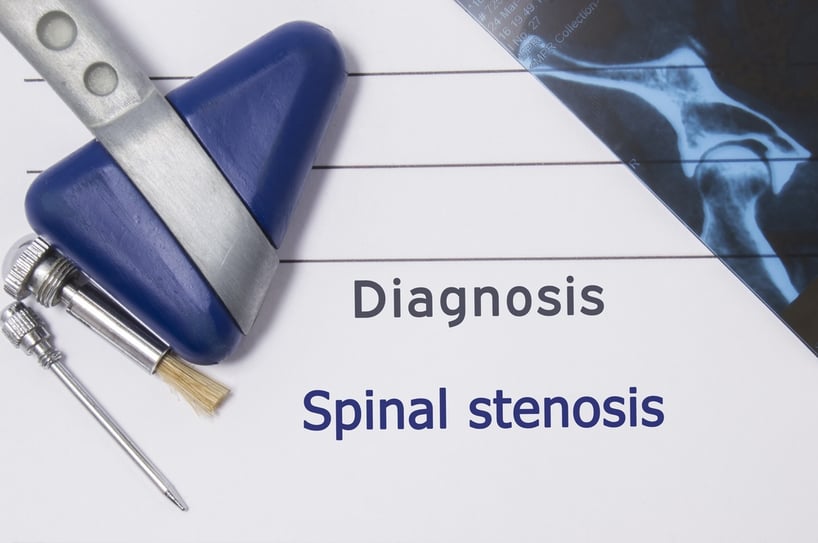SPINAL STENOSIS DIAGNOSIS AND TREATMENT: SURGICAL VS. NON-SURGICAL OPTIONS
June 14th, 2017 | 5 min. read


Spinal stenosis is a narrowing of the spinal canal in the neck (cervical stenosis) or in the lower back (lumbar stenosis). This condition puts pressure on the spinal cord and the nerves that branch off from it.
Stenosis can begin without any clear signs, but it usually progresses to include back pain, numbness in the arms and legs, urinary or bowel problems, and other symptoms.
If you think you may have this condition, you’re probably wondering, “How is spinal stenosis diagnosed, and what are my treatment options?”
DIAGNOSING SPINAL STENOSIS
If you have the signs and symptoms of spinal stenosis, you’ll need to make an appointment to see a physician for diagnosis. Stenosis must be confirmed with imaging tests that allow your doctor to see your spine and spinal canal.
Many different factors can contribute to stenosis, including vertebral fractures, slipped or herniated discs, tumors, arthritis, bone spurs, thickening of ligaments and tendons around the spine, and even swelling in surrounding soft tissue.
Because stenosis has so many possible causes, your doctor may need to order multiple tests to get a better understanding of what’s causing your issues. Spinal stenosis can be seen and confirmed with the following tests and scans:
- X-rays. X-rays show the vertebrae (back bones) and can help to determine if you have degeneration of the spine from age-related wear-and-tear or arthritis. X-rays can also show fractures, bony overgrowths, and changes to the shape of your vertebrae and the alignment of your spine.
- MRI (magnetic resonance imaging) constructs a three-dimensional image of your spine using radio waves. MRI shows soft tissue in addition to bone; it can create images of tumors or damage to muscles, ligaments, tendons, vertebral discs (the fluid-filled cushioning between your vertebrae), and nerves.
- CT scan (computerized tomography scan) uses X-ray technology to take cross-section “slices” of the body from different angles. Taken together, these images provide more detail than standard X-rays, and can show bone, joint, and soft tissue damage with the help of an injectable dye.
- Bone scan is a test using an injectable tracer—a small amount of radioactive substance that gets absorbed by the body. After administering the injection, lab technicians scan your spine to observe where the tracer is absorbed and to measure the degree. This test can check for damage due to certain bone diseases (like Paget’s disease), cancer, and infection.
- Electromyogram (EMG) and nerve conduction studies measure the electrical response of muscles and nerves. If your have leg symptoms—numbness or pain, or both—an EMG and nerve conduction test can determine which nerves are affected and whether the spinal cord is involved.
- Myelogram, or myelography, is a test that uses injected contrast dye and X-ray technology to create imaging of not just the spine itself, but also the spinal canal and the spaces between the vertebrae and nerves. Myelogram can help to detect issues like nerve irregularities, tumors, herniated discs, and inflammation of the membranous covering encasing the spinal cord.
NON-SURGICAL TREATMENT for spinal stenosis
How you choose to treat your spinal stenosis depends on the location of your injury (neck or lower back), the extent of the damage to your spine, and how much discomfort or dysfunction you are experiencing.
Your physician or orthopedist may recommend non-invasive treatment to start, especially if your symptoms aren’t negatively impacting your life in a significant way.
If you’re dealing with mild to moderate pain, numbness, and weakness, the primary objective of non-surgical stenosis treatment will be to minimize these symptoms and improve your function. If your symptoms aren’t severe or disabling, you may see some improvement with the following options.
- NSAIDs (non-steroidal anti-inflammatory drugs). If your primary issues are pain and inflammation, low doses of over-
 the-counter drugs like aspirin, acetaminophen, ibuprofen, and naproxen can help. However, NSAIDs are not a good long-term option for most people because they can promote bleeding and bruising and may contribute to ulcers. They may also conflict with prescription medications.
the-counter drugs like aspirin, acetaminophen, ibuprofen, and naproxen can help. However, NSAIDs are not a good long-term option for most people because they can promote bleeding and bruising and may contribute to ulcers. They may also conflict with prescription medications. - Corticosteroid injections. If inflammation is a problem (for example, due to a pinched and irritated nerve root), an injection to the site in your back or neck may help resolve the issue for a period of time. However, corticosteroid treatments should not be repeated more than a few times per year, as they have their own share of side effects, and repeated injections to the same location may weaken surrounding bone and tissue.
- Muscle relaxants, anti-seizure medications, antidepressants, opioids, or anesthetics. If your spinal stenosis presents with nerve damage, muscle spasms, or chronic pain, higher-strength prescription medications and injections may help to control symptoms, block pain signals, or ease discomfort. However, some of these are habit-forming and few of them can be used long-term due to side effects.
- Physical therapy. Many people with spinal stenosis (or any form of back, neck, or leg pain) mistakenly believe that exercise should be avoided. However, protecting your body from pain, in this case, may actually cause you more suffering in the long run. As your muscles weaken, your balance and posture can decline, which may contribute to pain in other parts of the body—or even worse, to a traumatic fall. A physical therapist can show you how to stretch and strengthen your body to reduce pain, improve range of motion, and preserve your strength and balance.
SURGICAL TREATMENT for spinal stenosis
Unfortunately, non-surgical treatments for spinal stenosis don’t work for everyone because they treat the symptoms and not  the underlying cause. The true issue is the crowding of the spinal canal, which is putting pressure on the spinal cord or nerves.
the underlying cause. The true issue is the crowding of the spinal canal, which is putting pressure on the spinal cord or nerves.
To eliminate the symptoms, this cause needs to be eliminated or fixed—and that usually involves spinal decompression surgery to relieve the pressure and create more space.
If conservative treatments aren’t helping or if you have disability (for example, trouble walking, constant pain, serious bowel or bladder dysfunction, or excessive numbness in your hands or feet), you may need to see an orthopedist to discuss a surgical option that will work for you.
Common spinal stenosis surgeries include:
- Sometimes, additional room can be created in the spinal canal by removing a portion of bone along the back of a vertebra, called the lamina. This is the part of the vertebra that forms a “roof” over the spinal cord. Laminectomy is a common back surgery and is generally considered a very safe procedure with a fast recovery. Post-surgery, you should be able to walk within two days. If you have significant degeneration of the affected vertebra, a laminectomy may need to be followed by a spinal fusion in order to stabilize the spine.
- Laminoplasty. This surgery is performed only in the cervical vertebrae of the neck. If you have cervical spinal stenosis, your orthopedist may be able to create more space inside the spinal canal by cutting to separate the two lamina from each other. The surgeon then creates a bone hinge or flap that’s propped up or spanned by metal hardware. This procedure creates extra room in the spinal canal without the need for spinal fusion, which can negatively affect flexibility and range of motion.
- This procedure is less extensive than laminectomy. Rather than taking the entire lamina, the surgeon removes only a portion of the bone to relieve pressure and create a larger opening for the spinal cord (for example, he or she might remove just one side of the lamina, or a small piece).
These surgeries can be very effective in reducing pain, numbness, and other spinal stenosis symptoms. However, like any operation, they do carry risks like infection, blood clots, and neurological side effects. Discuss surgery fully with your orthopedist to see if the risk vs. reward analysis makes sense for you.
SUMMARY
If you have signs and symptoms of spinal stenosis (narrowing of the spinal canal in the neck or the lower back), visit a physician to receive a diagnosis. Stenosis can only be confirmed with a full medical history and imaging tests.
If your symptoms are not severe and disabling, you may be able to get by with conservative treatments like NSAIDs, prescription medication, injections, and physical therapy.
However, if these don’t bring long-term relief or if your symptoms have progressed to the point where you are disabled by pain or mobility issues, spinal decompression surgery can be a safe and effective option.
Please call Coastal Orthopedics in Corpus Christi, Texas today to schedule an appointment for a consult today if you are suffering for back or neck pain at (361) 994-1166.
Article written by: Rob Williams, MD
Dr. Williams has been practicing orthopedic surgery in Corpus Christi since 1998. After graduating from Texas Tech hereceived his medical degree from the University of Texas at San Antonio. At the prestigious Campbell Clinic located at the University of Tennessee, Dr. Williams completed not only an Orthopedic Surgery Residency, but an additional year of Fellowship Training in Spine Surgery. Dr. Williams is dedicated to creating an excellent patient experience in the office or in the surgery suite.
Topics:

